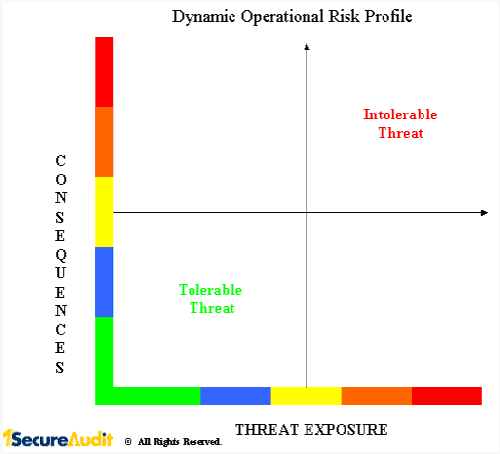Executive Summary
There is a growing threat on the business horizon. The risk of loss from inadequate or failed processes, people, and systems or from external events is taking executives by storm. This definition of Operational Risk also includes legal risk, which is the risk of loss from failure to comply with laws as well as prudent ethical standards and contractual obligations. It also includes exposure to litigation from all aspects of institutions activities. In the course of a single day the organizational exposure to threats ranges from low to severe on the horizontal axis. It isn’t until you put the vertical spectrum into consideration that you arrive at your "Operational Risk Profile" for that particular slice of time. This vertical axis is the range of consequences that would impact the business should the threat event actually occur. It ranges from minor to disastrous. Each day our organizations live in a dynamic spectrum of tolerable and intolerable threats to our most precious corporate assets.

The Mission
The organization shall develop, implement, maintain and continually improve a documented operational risk management system. Identify a method of risk assessment that is suited for the organizations business assets to be protected, regulatory requirements and corporate governance guidelines. Identify the assets and the owners of these assets. Identify the threats to those assets. Identify the vulnerabilities that might be exploited by the threats. Identify the impacts that losses of confidentiality, integrity and availability may have on the assets. Assess the risks. Identify and evaluate options for the treatment of risks. Select control objectives and controls for treatment of risks. Implement and operate the system. Monitor and review the system. Maintain and improve the system.
The Take Away
While you were in the Board of Directors meeting, your Operational Risk Profile changed. When you were asleep last night it changed again. The people, processes, systems and external events are interacting to create a new and dynamic threat matrix for your organization. Who is responsible for Operational Risk Management in your business? Everyone is. You see, if everyone in the organization was able to understand and perform the mission flawlessly, then the business could stay in the lower left quadrant. This is where the threat exposure is low and the consequences are minimal. This is exactly why you are spending less and less time here. Only a guarded few understand the mission of operational risk management in your company. Only a guarded few can do it flawlessly. If you want to protect your corporate assets better than you do today, then turn those guarded few into the mission ready many.
******************************
Peter L. Higgins is Managing Director of 1SecureAudit LLC, A global Operational Risk Management Solutions and Business Audit firm, headquartered in McLean, Virginia USA. 1SecureAudit designs, delivers and transfers a combination of proven risk methodologies, customized software and business audit services to assist financial services and healthcare clients maintain regulatory compliance, increase employee awareness and secure the continuity and reputation of their enterprises. Further information at http://www.1SecureAudit.com.
The content of this article is intended to provide a general guide to the subject matter. Specialist advice should be sought about your specific circumstances.
